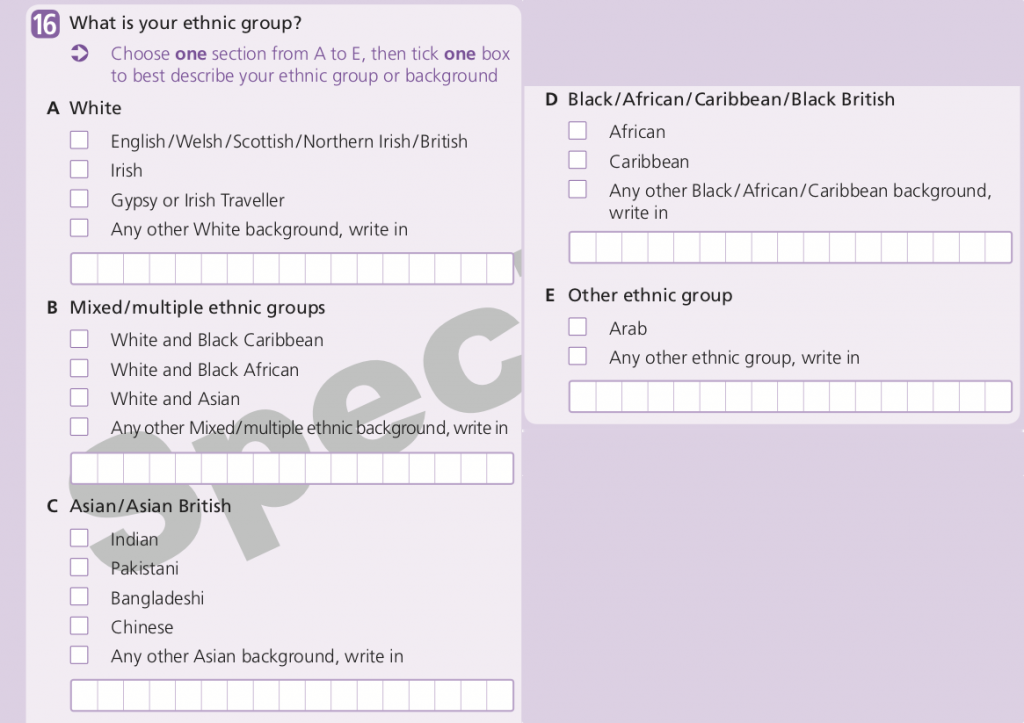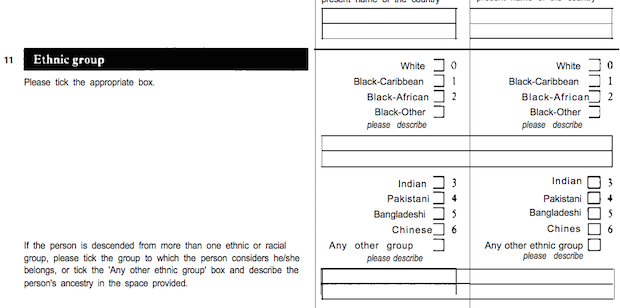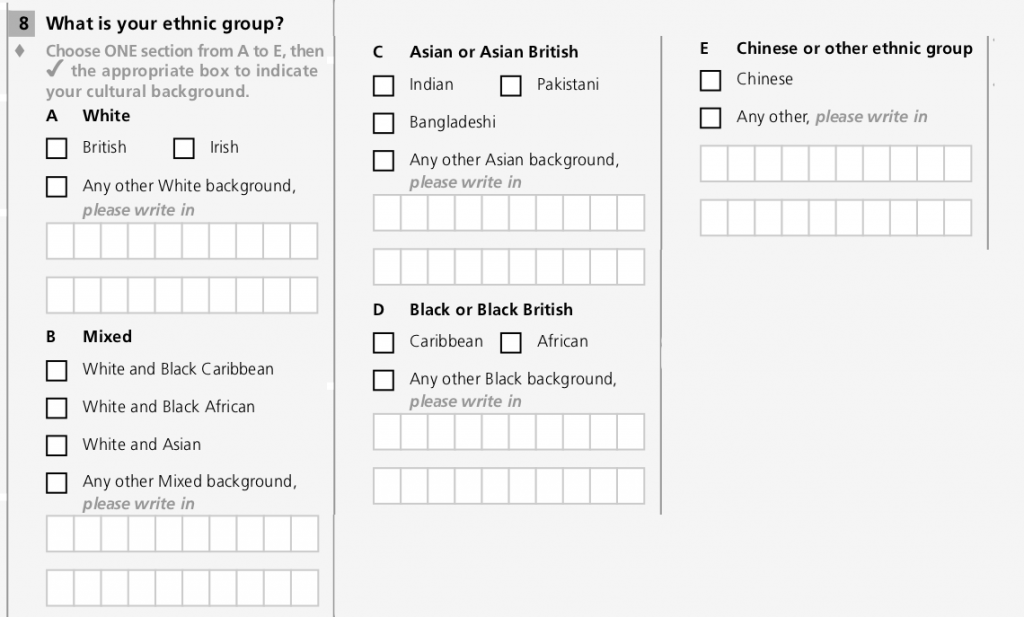
In every Census since 1841, people have been asked to state their country of birth and, in most cases, their nationality. However, asking about people’s ethnicity is a relatively new concept. This post looks at how ethnicity data collection has changed, the challenges the government has faced over the years, and the importance of collecting ethnicity data in a consistent way.
What is ethnicity?
The Equality Act 2010, the UK’s main anti-discrimination legislation, talks about ‘race’ rather than ethnicity. Race is described in terms of a person’s skin colour, nationality, and ethnic or national origins.
Ethnicity, however, is more subjective – it relates to a shared history and culture, language, religion and traditions, as well as skin colour.
The way that ethnic groups are defined has changed over time. Similarly, the way someone describes themselves may change as their perceptions, or society’s, change. And, society’s needs for information about ethnicity have changed over time.
This makes collecting ethnicity data, and measuring changes over time, challenging.
1960s: nationality over ethnicity
The terms ‘Old Commonwealth’ and ‘New Commonwealth’ were first used in the results of the 1966 sample Census to give an indication of the size of the White and non-White populations. People were classified according to whether they were born in:
- the Old Commonwealth (Australia, Canada and New Zealand)
- the New Commonwealth (including India, Pakistan, Bangladesh and the West Indies)
- the African Commonwealth (including Nigeria, Uganda and Kenya)
It is hard to see these groups as good indicators of ethnicity – for example, many people born in the New Commonwealth were White.
1970s: appearances and assumptions
The General Household Survey was the first large-scale survey to record the ethnic group of respondents. From its launch in 1971 until well into the 1980s, interviewers were asked to record whether respondents were White or ‘coloured’. Interviewers would often estimate a child’s ethnicity based on the child’s parents.
In 1975, the Office of Population Censuses and Surveys did some research into ethnicity in preparation for the 1981 Census. The aim was to:
- get information on ethnicity that wasn’t simply based on where someone’s parents were born
- phrase the question in such a way that it was acceptable and relatable to the public – for example, in the late 1970s many West Indians felt it inappropriate to describe people born in Britain as ‘West Indian’
1980s: slow progress
In the end, the 1981 Census didn’t include a question on ethnicity – something Parliament later said it regretted.
Instead, Census estimates on ethnicity were based on the number of people living in a household headed by someone born in one of the different ‘Commonwealth’ groups. People were therefore classified into broadly national ethnic groups such as Indians, West Indians and Pakistanis.
Further research in the 1980s looked at how people responded to possible changes, like ‘Afro-Caribbean’ being used instead of ‘West Indian’.
1990s: ethnicity in the Census for the first time

The 1991 Census was the first to include an ethnicity question (in both censuses in England and Wales, and in Scotland). The question included 9 boxes, 7 labelled with pre-coded categories and 2 allowing people to write in their ethnicity.
The classification was: White; Black-Caribbean; Black-African; Black-Other (write in); Indian; Pakistani; Bangladeshi; Chinese; Any other ethnic group (write in).
The Census question was adopted by the annual Labour Force Survey (LFS) from 1992; this established the cycle of intensive work to test new ethnicity questions for each Census, and their subsequent adoption on regular household surveys.
In the mid-late 1990s, LFS estimates showed a big increase in the ethnic minority population – this was thought to be partly due to fertility rates, but also (speculatively) changes in perceptions of ethnicity, particularly among people of mixed ancestry.
2000s: updating terms

The 2001 Census ethnicity question included Mixed ethnicity; this made the question more acceptable and relevant, though one downside was that it made it hard to compare with 1991 Census results, for some groups. Other changes included the use of the terms ‘Asian British’ and ‘Black British’. In addition, the 2001 Census included a (voluntary) question about religion.
While researching questions for the 2011 Census in England and Wales, the Office for National Statistics (ONS) discovered that although most of the respondents from all ethnic groups felt comfortable with the use of the terms "Black" and "White", some people found terms like ‘Black’ and ‘White’ confusing and unacceptable. They thought the terms didn’t adequately describe an individual's ethnic group, didn’t reflect his or her true skin colour, and were stereotypical and outdated terms.
In response, the 2001 Census category ‘Black or Black British’ was changed to ‘Black/African/Caribbean/Black British’ for the 2011 Census.
Two new categories were added, ‘Gypsy or Irish Traveller’ and ‘Arab’.
As with earlier censuses, individuals who didn’t identify as one of the listed options could choose to write in their own ethnic group.
What’s next: the 2021 Census
December 2018 saw the publication of the 2021 Census White Paper, which proposes further changes to the ethnicity classification - specifically, the addition of a tick box for the Roma population, and a ‘search as you type’ facility to make it easier for people of Somali origin to use the write in under ‘Black African’.
The Race Disparity Unit is also researching how different government services ask users about their ethnicity.
Looking ahead, there are 3 main challenges facing us as we seek to make ethnicity data collection more consistent across government:
- making sure any collection of ethnicity data meets the new General Data Protection Regulation (GDPR) – in other words, only asking for people’s ethnicity when there’s a clear need to do so and keeping their information secure
- finding the best way to ask people about their ethnicity, using a consistent list of ethnic groups that people identify with and find acceptable
- adapting to the continuing changes in how we think about ethnicity, with even greater emphasis on language, culture and religion, and greater variation in ancestry of those of Mixed origin
Sources:
1991 Census England H form for private households, UK Data service
Census 2001 England Household form, Office for National Statistics
2011 Census England Household questionnaire, ONS
Keep tabs on the past.Sign up for our email alerts.